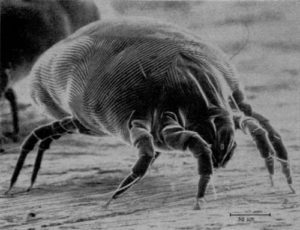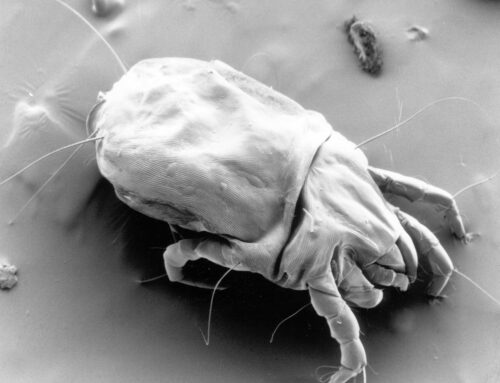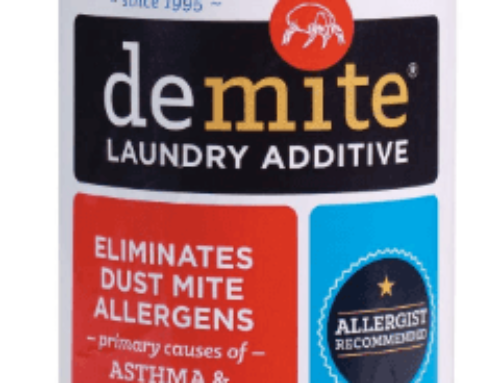When you realized that you’re suffering from dust mites allergies, you’ll want to take proactive measures to reduce the pest. I’ve been battling dust mites in my home for quite a while, and this fact sheet helps you to understand the creature and ways to reduce its growth.
Quick Facts About Dust Mites
 Here are some brief details about dust mites.
Here are some brief details about dust mites.
- Dust mites belong to the arachnids family, which means they are close relatives of spiders and other mites.
- You can’t detect dust mites with your bare eyes as each adult mite measures approximately 0.3 mm.
- Common species of dust mites in the US are the North American dust mites, Dermatophagoides farinae, and the European dust mites, D. pteronyssinus. Other species like D. siboney and B. tropicalis are found in other parts of the planet.
- Dust mites are more common than you think. About 4 out of 5 homes in the US are infested with dust mites.
- The average lifespan of a dust mite is about 90 days.
- Female dust mites lay between 20-80 eggs in its lifecycle. This means that the growth of dust mites can increase exponentially in the right environment.
- Dust mites don’t bite on human flesh. It is a common myth that they do. If you’re getting bite marks, chances are you’re having bed bugs or other pests in your home.
- These microscopic pests feed on dead skin cells. An individual typically shed millions of skin cells per day, and that means ample food supply for 1 million dust mites.
- Dust mites thrive in environments with humidity of 70% – 80% and temperature between 20°C – 25°C (68°F – 77°F). They couldn’t breed when the environment is beyond the parameter range.
- The bedroom often has the highest concentration of dust mites and there could be up to 10 million of dust mites present in a mattress.
- Other common spots for dust mites are the carpets, sofa, upholstery, and areas that easily accumulate dust.
- Dust mites allergies are caused by the protein found in their excretion. A single fecal pellet measures between 20um to 40um and about 20 are excreted daily by a dust mite.
- Household pets, like cats and dogs, are not spared from dust mites. Pets exposed to dust mites may suffer atopic dermatitis.
- Common dust mites allergy symptoms are coughing, sneezing, teary eyes, itchy throat, runny nose, nasal inflammation, and itchy skin.
- Dust mite allergy may lead to asthma or aggravate existing conditions.
- Dust mites allergen may worsen eczema.
- About 20 million Americans are suffering from dust mites allergies.
- Regular washing is not effective to kill dust mites.
- Making your bed in the morning may trap moisture, and encourage the growth of dust mites.
- The HEPA filter, which traps 99.97% particles of 0.3 microns, is effective for trapping dust mites and its fecal pellets.
- The absence of dust may not indicate your home is free of dust mites. These creatures could have burrowed deep in fabric upholstery or mattress.
- 75% of dust mites weight is made up of water.
Treating Dust Mites Allergies
If you’re suffering from dust mites allergies, you ought to consult a doctor to have your symptoms diagnosed and treated. Often a skin prick test is done to find out if you’re an allergy to dust mites allergen.
Your doctor will then prescribe medicine like antihistamine, corticosteroid, and decongestants to deal with the symptoms.
Killing And Preventing Dust Mites Growth
Medications are only part of the equation in alleviating dust mites allergy. Here are some of the steps you could take to reduce dust mites in your home to the extent that they don’t trigger the allergy. Bear in mind that you can’t kill every single dust mite in your home.
Here are some practical tips that help.
- Clean beddings regularly – Considering that you’ll be sleeping in the bed for hours, you’ll want to ensure you’re not sleeping with millions of dust mites. Clean the mattress covers, pillowcases, and other beddings weekly or twice a month. It helps if to use special cleaning detergent for dust mites, or increase the temperature in the dryer to kill the pests.
- Vacuum the mattress – A great number of dust mites may have burrowed deep in the mattress. Use a UV vacuum cleaner with a motorized mechanism to beat the dust mites to the surface. The UV light, heat will kill the dust mites and the allergen will be trapped with the HEPA filter.
- Steam clean the carpet – If you have thick carpets in your home, killing or removing the trapped dust mites is tough. Using a high power carpet steam cleaner is the last option, to eliminate the bugs right on the spot.
- Unclutter your home – If you have a bad habit of hoarding items, even unnecessary ones, you’ll need to start uncluttering. It’s easier to keep an uncluttered home clean, and potentially free from dust mites.
- Use dust mite sprays – It’s quite true that some household items like baking soda and bleach do kill dust mites, I personally prefer using essential oils or organic dust mite sprays. They are safer for humans, pets and the environment.
- Keep humidity low – Open windows for air to flow and remove moisture from your home. However, if you have poor natural ventilation in your home, you ought to install an exhaust fan or a dehumidifier. Lowering the humidity level greatly helps to reduce dust mite growth.
- Install a HEPA air purifier – An air purifier may not be able to remove dust mites from mattresses or carpets, but it helps to trap dust mites allergen that is in the air. It didn’t take much to send tiny particles of fecal pellets to the air and into your respiratory system.
- Use Dust Mite Covers for Beddings – If you’re highly sensitive to dust mites, it’s advisable to use a hypoallergenic mattress. However, lower-cost solutions such as dust mite covers for beddings help to minimize dust mites exposure when you’re sleeping.
It takes time to get rid of the allergy symptoms, but to keep them from recurring, you’ll need to have the discipline to keep your home clean. Hopefully, this compact fact sheet helps in controlling dust mites’ growth in your home.
Please share this article with someone who’s suffering from dust mites allergy.




Leave A Comment